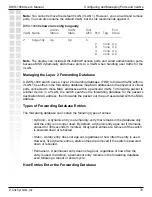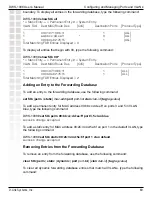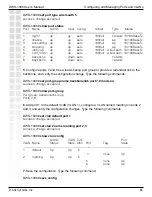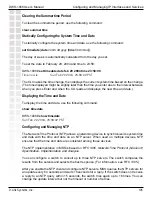
91
DWS-1008 User’s Manual
D-Link Systems, Inc.
Configuring and Managing IP Interfaces and Services
If the IP route table contains an explicit route for a given destination, MSS uses the route.
Otherwise, MSS uses a default route. For example, if the route table does not have a route to
host 192.168.1.10, the Switch uses the default route to forward a packet addressed to that
host. D-Link recommends that you configure at least one default route.
You can configure a maximum of four routes per destination. This includes default routes,
which have destination 0.0.0.0/0. Each route to a given destination must have a unique
gateway address. When the route table contains multiple default routes or multiple explicit
routes to the same destination, MSS uses the route with the lowest metric (cost for using the
route). If two or more routes to the same destination have the lowest cost, MSS selects the
first route in the route table. MSS can use a route only if the route is resolved by a direct route
on one of the Switch’s VLANs.
Note:
Before you add a static route, use the
show interface
command to verify that the
switch has an IP interface in the same subnet as the route’s gateway router. MSS requires
the routes for the interface to resolve the static route. If the switch does not have an interface
in the gateway’s subnet, the static route cannot be resolved and the VLAN:Interface field of
the
show ip route
command output shows that the static route is down.
Displaying IP Routes
To display IP routes, use the following command:
show ip route
[
destination
]
The
destination
parameter specifies a destination IP address.
To display the IP route table, type the following command:
DWS-1008#
show ip route
Router table for IPv4
Destination/Mask Proto Metric
NH-Type
Gateway VLAN:Interface
-------------------------------------------------------------------------------------------------------------------
0.0.0.0/ 0
Static 1
Router
10.0.1.17
vlan:1:ip
0.0.0.0/ 0
Static 2
Router
10.0.2.17
vlan:2:ip
10.0.1.1/24
IP
0
Direct
vlan:1:ip
10.0.1.1/32
IP
0
Local
vlan:1:ip:10.0.1.1/24
10.0.1.255/32
IP
0
Local
vlan:1:ip:10.0.1.1/24
10.0.2.1/24
IP
0
Direct
vlan:2:ip
10.0.2.1/32
IP
0
Local
vlan:2:ip:10.0.1.1/24
10.0.2.255/32
IP
0
Local
vlan:2:ip:10.0.1.1/24
224.0.0.0/ 4
IP
0
Local
MULTICAST
This example shows dynamic routes added by MSS for two VLAN interfaces, 10.0.1.1/24
on VLAN 1 and 10.0.2.1/24 on VLAN 2.






























